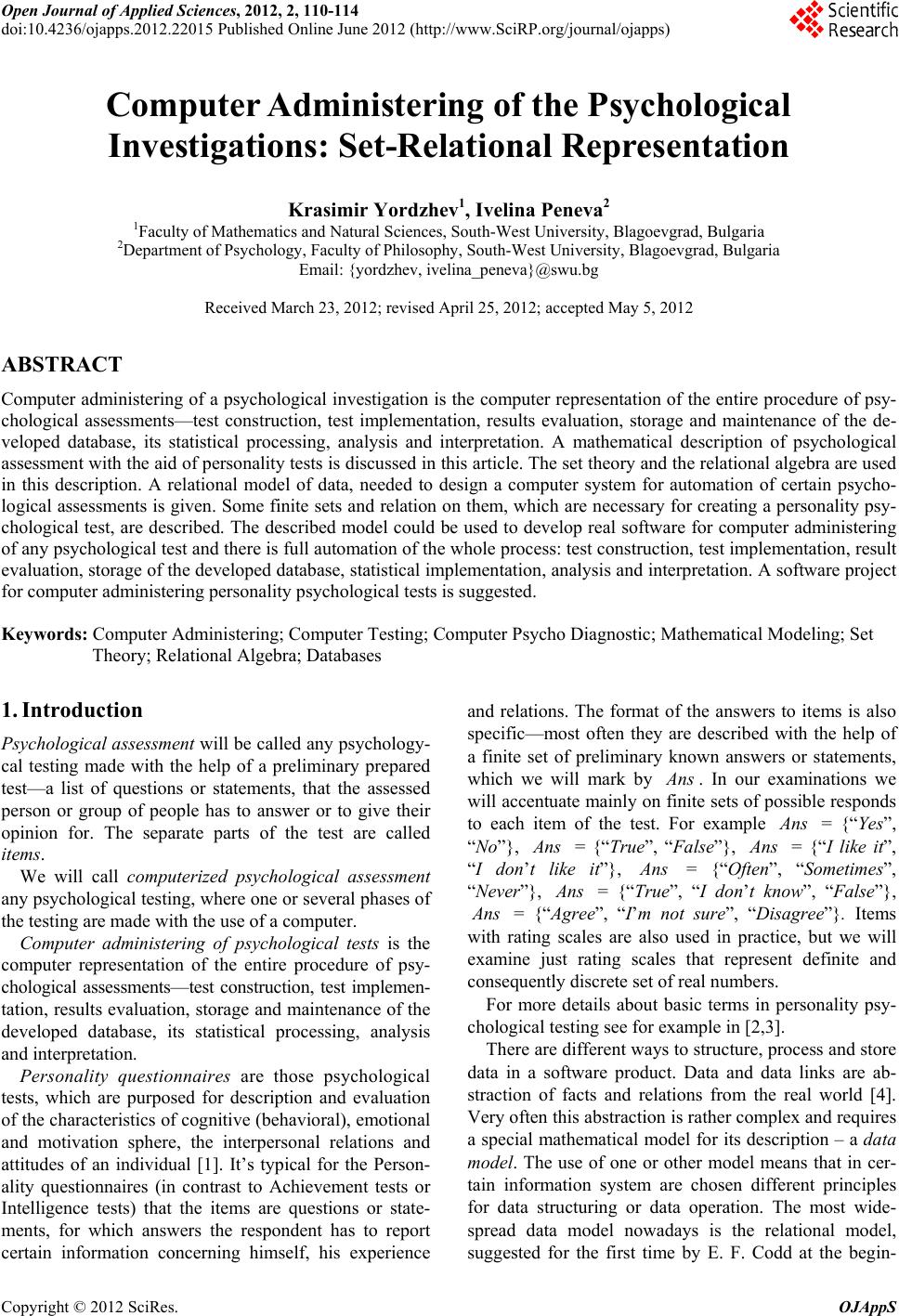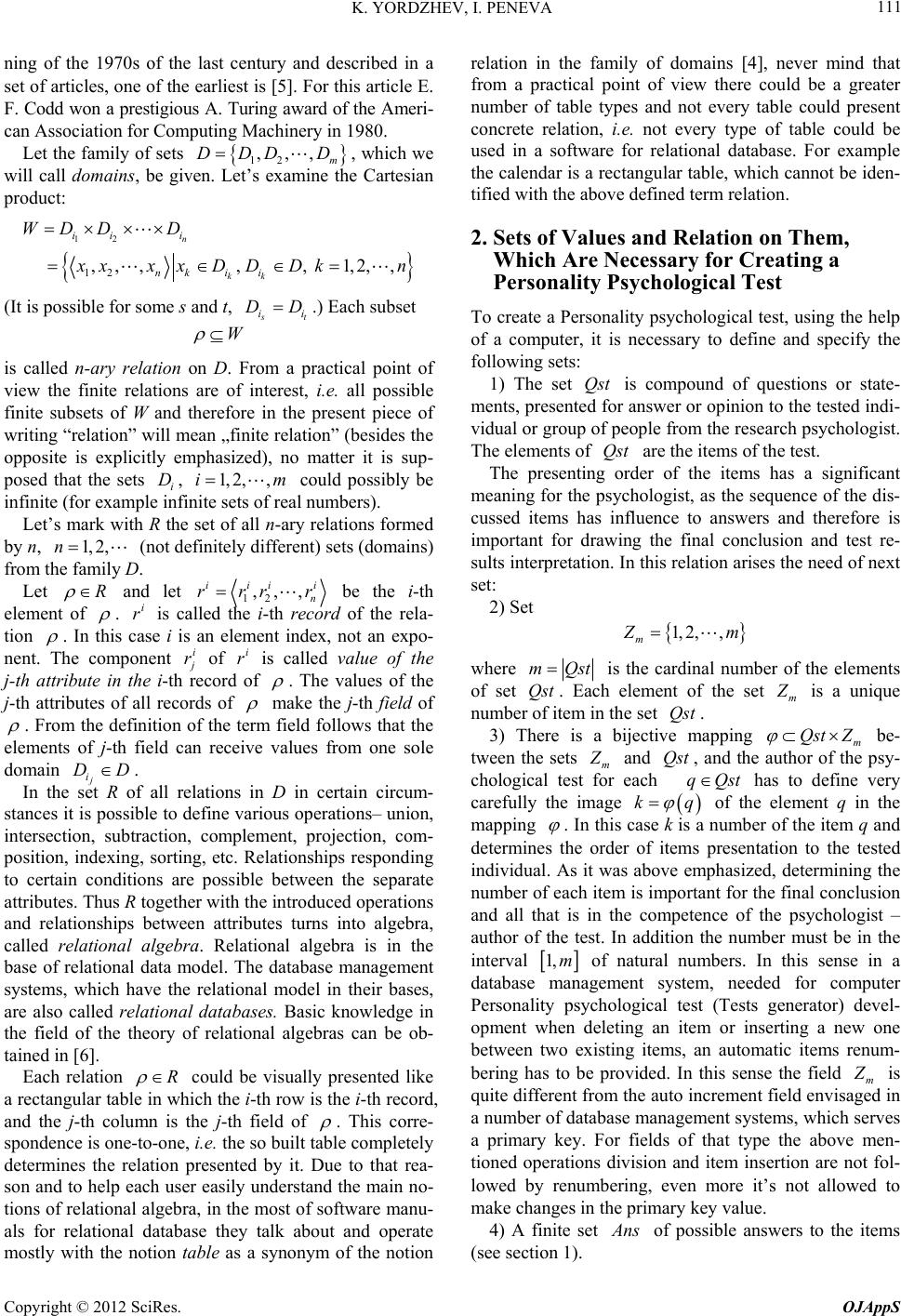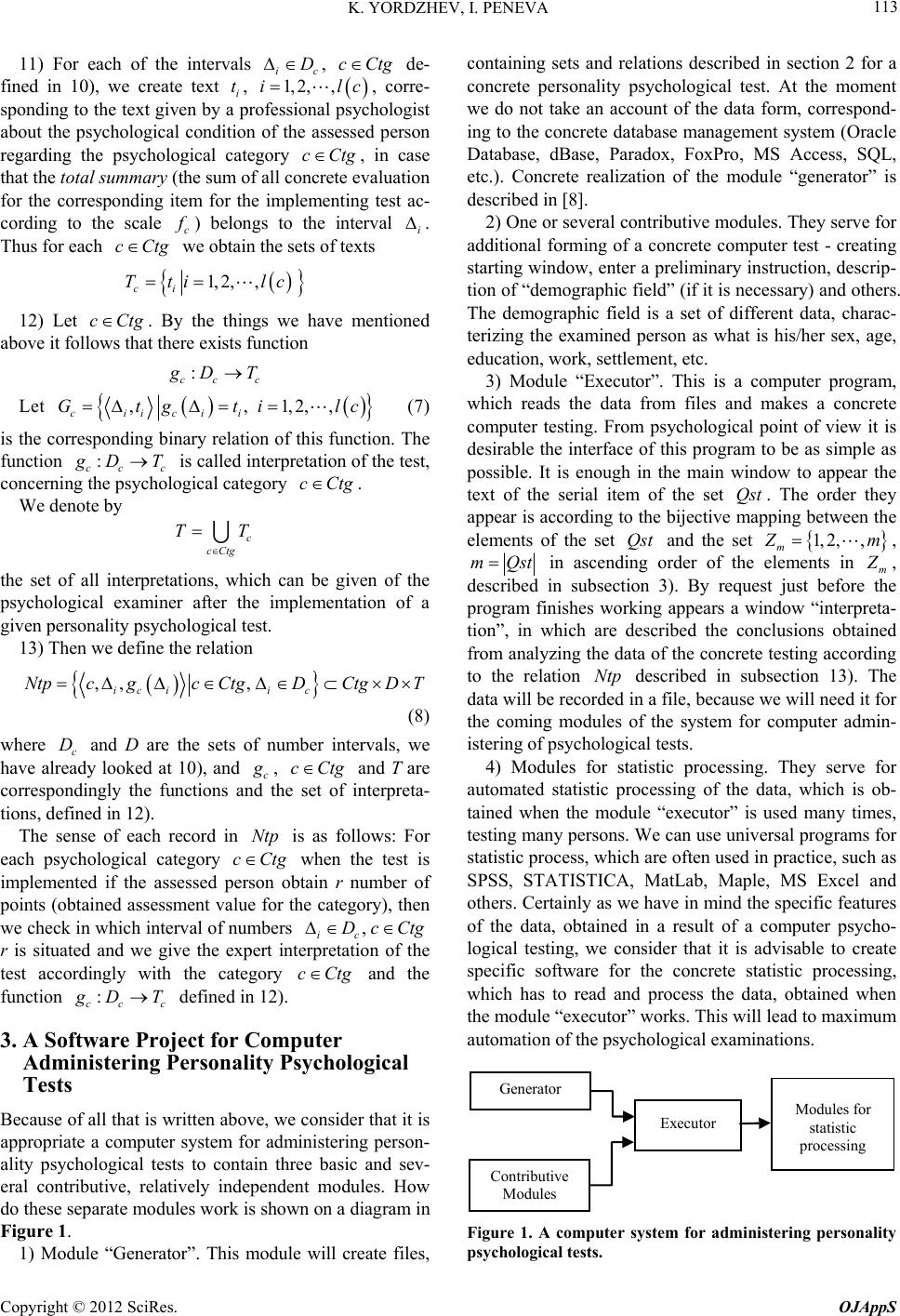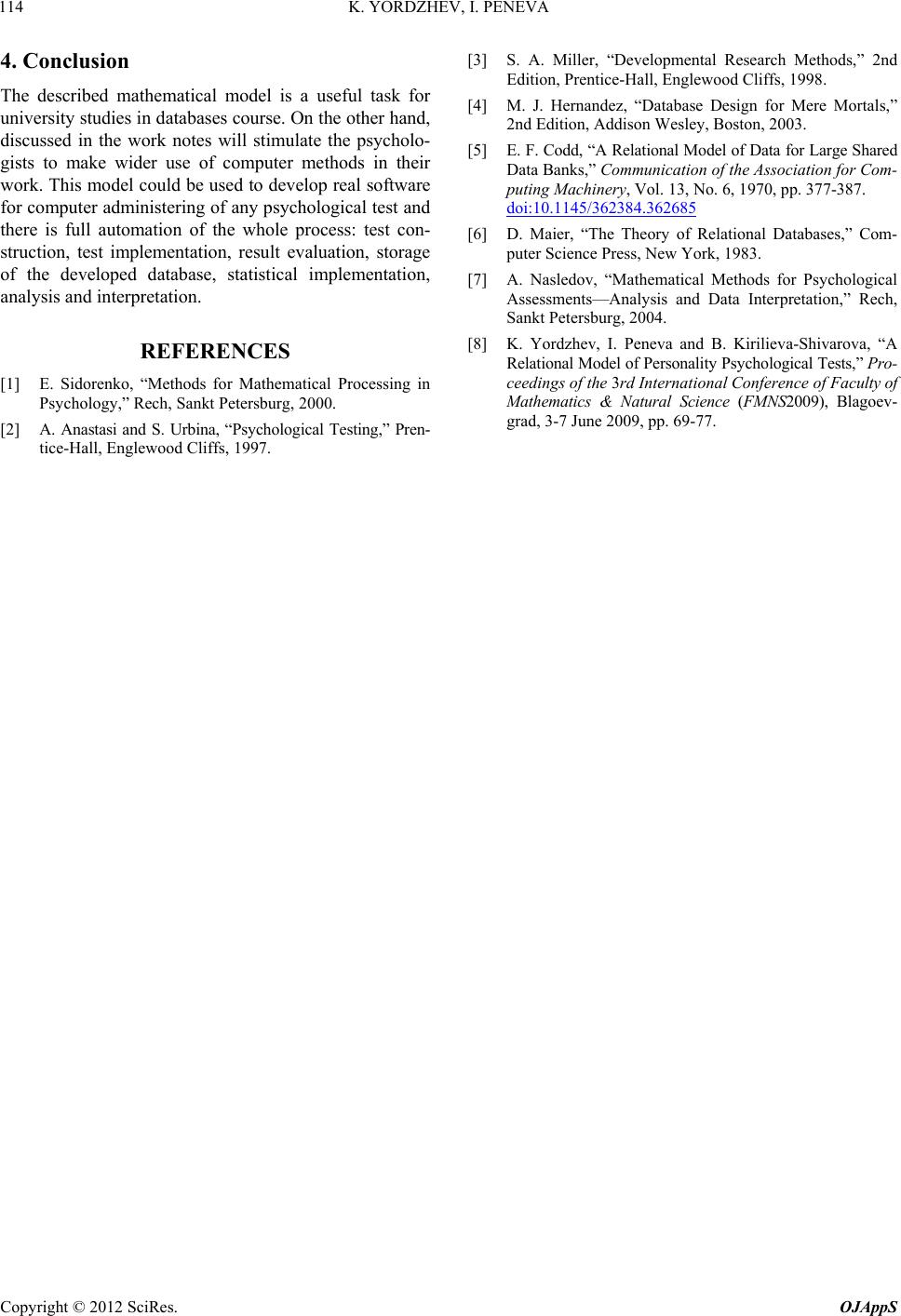 Open Journal of Applied Sciences, 2012, 2, 110-114 doi:10.4236/ojapps.2012.22015 Published Online June 2012 (http://www.SciRP.org/journal/ojapps) Computer Administering of the Psychological Investigations: Set-Relational Representation Krasimir Yordzhev1, Ivelina Peneva2 1Faculty of Mathematics and Natural Sciences, South-West University, Blagoevgrad, Bulgaria 2Department of Psychology, Faculty of Philosophy, South-West University, Blagoevgrad, Bulgaria Email: {yordzhev, ivelina_peneva}@swu.bg Received March 23, 2012; revised April 25, 2012; accepted May 5, 2012 ABSTRACT Computer administering of a psychological investigation is the computer representation of the entire procedure of psy- chological assessments—test construction, test implementation, results evaluation, storage and maintenance of the de- veloped database, its statistical processing, analysis and interpretation. A mathematical description of psychological assessment with the aid of personality tests is discussed in this article. The set theory and the relational algebra are used in this description. A relational model of data, needed to design a computer system for automation of certain psycho- logical assessments is given. Some finite sets and relation on them, which are necessary for creating a personality psy- chological test, are described. The described model could be used to develop real software for computer administering of any psychological test and there is full automation of the whole process: test construction, test implementation, result evaluation, storage of the developed database, statistical implementation, analysis and interpretation. A software project for computer administering personality psychological tests is suggested. Keywords: Computer Administering; Computer Testing; Computer Psycho Diagnostic; Mathematical Modeling; Set Theory; Relational Algebra; Databases 1. Introduction Psychological assessment will be called any psychology- cal testing made with the help of a preliminary prepared test—a list of questions or statements, that the assessed person or group of people has to answer or to give their opinion for. The separate parts of the test are called items. We will call computerized psychological assessment any psychological testing, where one or several phases of the testing are made with the use of a computer. Computer administering of psychological tests is the computer representation of the entire procedure of psy- chological assessments—test construction, test implemen- tation, results evaluation, storage and maintenance of the developed database, its statistical processing, analysis and interpretation. Personality questionnaires are those psychological tests, which are purposed for description and evaluation of the characteristics of cognitive (behavioral), emotional and motivation sphere, the interpersonal relations and attitudes of an individual [1]. It’s typical for the Person- ality questionnaires (in contrast to Achievement tests or Intelligence tests) that the items are questions or state- ments, for which answers the respondent has to report certain information concerning himself, his experience and relations. The format of the answers to items is also specific—most often they are described with the help of а finite set of preliminary known answers or statements, which we will mark by ns . In our examinations we will accentuate mainly on finite sets of possible responds to each item of the test. For example ns = {“Yes”, “No”}, ns = {“True”, “False”}, ns = {“I like it”, “I don’t like it”}, ns = {“Often”, “Sometimes”, “Never”}, ns = {“True”, “I don’t know”, “False”}, ns = {“Agree”, “I’m not sure”, “Disagree”}. Items with rating scales are also used in practice, but we will examine just rating scales that represent definite and consequently discrete set of real numbers. For more details about basic terms in personality psy- chological testing see for example in [2,3]. There are different ways to structure, process and store data in a software product. Data and data links are ab- straction of facts and relations from the real world [4]. Very often this abstraction is rather complex and requires a special mathematical model for its description – a data model. The use of one or other model means that in cer- tain information system are chosen different principles for data structuring or data operation. The most wide- spread data model nowadays is the relational model, suggested for the first time by E. F. Codd at the begin- Copyright © 2012 SciRes. OJAppS  K. YORDZHEV, I. PENEVA 111 ning of the 1970s of the last century and described in a set of articles, one of the earliest is [5]. For this article E. F. Codd won a prestigious A. Turing award of the Ameri- can Association for Computing Machinery in 1980. Let the family of sets 12 ,,, m DDD D, which we will call domains, be given. Let’s examine the Cartesian product: 12 12 ,,,,,1,2,, n kk ii i nki i WDDD xxxDDDk n (It is possible for some s and t, t i DDi .) Each subset W is called n-аrу relation on D. From a practical point of view the finite relations are of interest, i.e. all possible finite subsets of W and therefore in the present piece of writing “relation” will mean „finite relation” (besides the opposite is explicitly emphasized), no matter it is sup- posed that the sets i, could possibly be infinite (for example infinite sets of real numbers). D1, 2,,im Let’s mark with R the set of all n-ary relations formed by n, (not definitely different) sets (domains) from the family D. 1, 2,n Let R and let 12 ,, , iii i n rrr r be the i-th element of . is called the i-th record of the rela- tion i r . In this case i is an element index, not an expo- nent. The component i r of is called value of the j-th attribute in the i-th record of i r . The values of the j-th attributes of all records of make the j-th field of . From the definition of the term field follows that the elements of j-th field can receive values from one sole domain . j i In the set R of all relations in D in certain circum- stances it is possible to define various operations– union, intersection, subtraction, complement, projection, com- position, indexing, sorting, etc. Relationships responding to certain conditions are possible between the separate attributes. Thus R together with the introduced operations and relationships between attributes turns into algebra, called relational algebra. Relational algebra is in the base of relational data model. The database management systems, which have the relational model in their bases, are also called relational databases. Basic knowledge in the field of the theory of relational algebras can be ob- tained in [6]. DD Each relation R could be visually presented like a rectangular table in which the i-th row is the i-th record, and the j-th column is the j-th field of . This corre- spondence is one-to-one, i.e. the so built table completely determines the relation presented by it. Due to that rea- son and to help each user easily understand the main no- tions of relational algebra, in the most of software manu- als for relational database they talk about and operate mostly with the notion table as a synonym of the notion relation in the family of domains [4], never mind that from a practical point of view there could be a greater number of table types and not every table could present concrete relation, i.e. not every type of table could be used in a software for relational database. For example the calendar is a rectangular table, which cannot be iden- tified with the above defined term relation. 2. Sets of Values and Relation on Them, Which Are Necessary for Creating a Personality Psychological Test To create a Personality psychological test, using the help of a computer, it is necessary to define and specify the following sets: 1) The set is compound of questions or state- ments, presented for answer or opinion to the tested indi- vidual or group of people from the research psychologist. The elements of are the items of the test. Qst Qst The presenting order of the items has a significant meaning for the psychologist, as the sequence of the dis- cussed items has influence to answers and therefore is important for drawing the final conclusion and test re- sults interpretation. In this relation arises the need of next set: 2) Set 1, 2,, m m where mQst is the cardinal number of the elements of set . Each element of the set Qst m is a unique number of item in the set . Qst 3) There is a bijective mapping m Qst Z be- tween the sets m and , and the author of the psy- chological test for each has to define very carefully the image Qst qQst k q of the element q in the mapping . In this case k is a number of the item q and determines the order of items presentation to the tested individual. As it was above emphasized, determining the number of each item is important for the final conclusion and all that is in the competence of the psychologist – author of the test. In addition the number must be in the interval 1, m of natural numbers. In this sense in a database management system, needed for computer Personality psychological test (Tests generator) devel- opment when deleting an item or inserting a new one between two existing items, an automatic items renum- bering has to be provided. In this sense the field m is quite different from the auto increment field envisaged in a number of database management systems, which serves a primary key. For fields of that type the above men- tioned operations division and item insertion are not fol- lowed by renumbering, even more it’s not allowed to make changes in the primary key value. 4) A finite set ns of possible answers to the items (see section 1). Copyright © 2012 SciRes. OJAppS  K. YORDZHEV, I. PENEVA 112 5) A set of psychological categories (Personal- ity characteristics), which are subject of analysis and evaluation concerning the assessed individual or group of people with the aid of the items from the set and the concrete answer that is chosen. It is not obligatory for each item to be related to given psychological category. Ctg Qst 6) We are examining the finite family of subsets of Qst c TTQstcCtg t (2) with the element which belongs to the subset , if and only if the item q has a relation to the category in the correspondent psychological assessment. qQst c T cCtg Obviously and if and , then the item q will not effect the entire test and will drop out. c cCtg TQs T qQst c cCtg q 7) Let 12 ,,, k nsa aa. For every i we put together the set of numbers i, i.e. we examine the following family of sets of numbers aAns S ,1,2,, ii Sa Ansik We are building the Cartesian product of the sets , : i S 1, 2,,ik 12 ,,,,1,2,,, i i aAns ki i Scl S sssSikkAns Each element ii S, aAns from a practical point of view represents an assessment numerical value of the psychological categories from the set Ctg on condition that the assessed person could possibly respond to a random item with an answer or a statement aAns . Quite often these assessment values are 1 or 0. For ex- ample, if 2Ans and we assume that the assessment value for each positive answer is equal to 1 and for each negative answer is 0, then we can easily calculate the total number of positive answers. 8) Let’s remind that a binary relation AB is called function, if for each A there is no more than one B, so that , yf. The fact that AB : is a function is presented also like that AB and instead of , yf, we write f x cC . For each psychological category is defined one function tg : c Qst Scl cCtg cC with the aid of which the psychologist evaluates the assessed person regarding the category . Such function is called a scale for the psychological category . It’s a common practice the name of the scale to be exactly the same as the name of the psychological category. The set of functions tg c What is the assessment of the different items, regard- ing the correspondent answers, i.e. how the functions are defined : c Qst Scl, and what is the in- fluence of this to the summary assessment of the test implementation can be estimated after wide psychology- cal and statistical investigations [1-3,7]. cCtg 9) Relation ,,, c Bndc qfqcCtgqQstCtgQstScl where , and are sets, which are defined correspondingly in subsections 5), 1) and 7), and the relation c Ctg Qst Scl , cCtg is a function defined in 8) (scale of psychological category c). Every record in DBName_ Bnd contains the number of the scores we can take when the person does the corresponding answer aAns ac- cording the scale c q for category and item cCtg qQst . 10) Let cCtg and let min c qQst m c fq (5) where 12 12 ,,,min,,, kk xx xxx In other words c is the minimum assessment value (minimum score), which could possibly be obtained in a random testing, related to the category cC m tg and depending on the correspondent scale : c Qst Scl . Analogously we specify the maximum assessment value max c qQst c fq (6) where 12 12 ,,,max ,,, kk xxxxx Obviously c mM c . We examine the finite sequence of numbers 01 1. cc lc lc mbbbb M As we denote lc we emphasize the fact that the number of the members in the row depends on the cate- gory .cCtg We are separating the interval , cc mM to the subintervals 0 ,bb 1 , 12 ,bb, 23 ,bb , ···, 1,bb lclc. Let’s mark with the set of all intervals of that type c D 10 ,bb 1 and 1, iii bb , l2, 3,,ic, corresponding to the category cCtg . The number lc and each of the intervalsi , 1, 2,,ilc should be a result of profound psycho- logical investigations. Let denote by c cCtg DD cCtg , composed by all scales for the examined psychological categories is called a scale of the Person- ality psychological test. the set of all intervals of numbers, which could be useful for certain personality psychological test. Copyright © 2012 SciRes. OJAppS  K. YORDZHEV, I. PENEVA 113 11) For each of the intervals , de- fined in 10), we create text i t, , corre- sponding to the text given by a professional psychologist about the psychological condition of the assessed person regarding the psychological category cC, in case that the total summary (the sum of all concrete evaluation for the corresponding item for the implementing test ac- cording to the scale c ic D 1, 2,i cCtg ,lc tg ) belongs to the interval i . Thus for each we obtain the sets of texts cCtg 1, 2,, ci Tti lc 12) Let . By the things we have mentioned above it follows that there exists function cCtg : cc c DT Let ,,1,2, ciicii Gtgti l ,c (7) is the corresponding binary relation of this function. The function c : cc DT is called interpretation of the test, concerning the psychological category . cCtg We denote by c cCtg TT the set of all interpretations, which can be given of the psychological examiner after the implementation of a given personality psychological test. 13) Then we define the relation ,, , ic iic NtpcgcCtgDCtgD T (8) where c and D are the sets of number intervals, we have already looked at 10), and c D , and T are correspondingly the functions and the set of interpreta- tions, defined in 12). cCtg The sense of each record in is as follows: For each psychological category cC when the test is implemented if the assessed person obtain r number of points (obtained assessment value for the category), then we check in which interval of numbers r is situated and we give the expert interpretation of the test accordingly with the category and the function Ntp tg , ic Dc Ctg cCtg : cc c DT defined in 12). 3. A Software Project for Computer Administering Personality Psychological Tests Because of all that is written above, we consider that it is appropriate a computer system for administering person- ality psychological tests to contain three basic and sev- eral contributive, relatively independent modules. How do these separate modules work is shown on a diagram in Figure 1. 1) Module “Generator”. This module will create files, containing sets and relations described in section 2 for a concrete personality psychological test. At the moment we do not take an account of the data form, correspond- ing to the concrete database management system (Oracle Database, dBase, Paradox, FoxPro, MS Access, SQL, etc.). Concrete realization of the module “generator” is described in [8]. 2) One or several contributive modules. They serve for additional forming of a concrete computer test - creating starting window, enter a preliminary instruction, descrip- tion of “demographic field” (if it is necessary) and others. The demographic field is a set of different data, charac- terizing the examined person as what is his/her sex, age, education, work, settlement, etc. 3) Module “Executor”. This is a computer program, which reads the data from files and makes a concrete computer testing. From psychological point of view it is desirable the interface of this program to be as simple as possible. It is enough in the main window to appear the text of the serial item of the set . The order they appear is according to the bijective mapping between the elements of the set and the set Qst Qst 1, 2,, m m, mQst in ascending order of the elements in m , described in subsection 3). By request just before the program finishes working appears a window “interpreta- tion”, in which are described the conclusions obtained from analyzing the data of the concrete testing according to the relation described in subsection 13). The data will be recorded in a file, because we will need it for the coming modules of the system for computer admin- istering of psychological tests. Ntp 4) Modules for statistic processing. They serve for automated statistic processing of the data, which is ob- tained when the module “executor” is used many times, testing many persons. We can use universal programs for statistic process, which are often used in practice, such as SPSS, STATISTICA, MatLab, Maple, MS Excel and others. Certainly as we have in mind the specific features of the data, obtained in a result of a computer psycho- logical testing, we consider that it is advisable to create specific software for the concrete statistic processing, which has to read and process the data, obtained when the module “executor” works. This will lead to maximum automation of the psychological examinations. Contributive Modules Generator Modules for statistic processing Executor Figure 1. A computer system for administering personality psychological tests. Copyright © 2012 SciRes. OJAppS  K. YORDZHEV, I. PENEVA Copyright © 2012 SciRes. OJAppS 114 4. Conclusion The described mathematical model is a useful task for university studies in databases course. On the other hand, discussed in the work notes will stimulate the psycholo- gists to make wider use of computer methods in their work. This model could be used to develop real software for computer administering of any psychological test and there is full automation of the whole process: test con- struction, test implementation, result evaluation, storage of the developed database, statistical implementation, analysis and interpretation. REFERENCES [1] E. Sidorenko, “Methods for Mathematical Processing in Psychology,” Rech, Sankt Petersburg, 2000. [2] A. Anastasi and S. Urbina, “Psychological Testing,” Pren- tice-Hall, Englewood Cliffs, 1997. [3] S. A. Miller, “Developmental Research Methods,” 2nd Edition, Prentice-Hall, Englewood Cliffs, 1998. [4] M. J. Hernandez, “Database Design for Mere Mortals,” 2nd Edition, Addison Wesley, Boston, 2003. [5] E. F. Codd, “A Relational Model of Data for Large Shared Data Banks,” Communication of the Association for Com- puting Machinery, Vol. 13, No. 6, 1970, pp. 377-387. doi:10.1145/362384.362685 [6] D. Maier, “The Theory of Relational Databases,” Com- puter Science Press, New York, 1983. [7] A. Nasledov, “Mathematical Methods for Psychological Assessments—Analysis and Data Interpretation,” Rech, Sankt Petersburg, 2004. [8] K. Yordzhev, I. Peneva and B. Kirilieva-Shivarova, “A Relational Model of Personality Psychological Tests,” Pro- ceedings of the 3rd International Conference of Faculty of Mathematics & Natural Science (FMNS2009), Blagoev- grad, 3-7 June 2009, pp. 69-77.
|